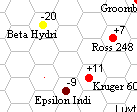
Starmap
Wot map? It's a 44K GIF file.
The map is intended to show all stars within 20 light years (l.y.) of Earth plus a few interesting ones a bit further away such as Fomalhaut. 'Sol' is naturally in the centre of the hex grid, which is aligned to the celestial equator. Each hex is one light year across, and the plus/minus numbers for each star indicate it's Z coordinate. For example, Epsilon Indi should be thought of as being 9 hexes below the plane of the map, and can only be seen from southern skies.
Spectral Class is indicated by colour. Almost all the stars are Main Sequence, exceptions include Procyon (a SubGiant) and Van Maanan's Star (a Yellow Dwarf). Multiple star systems are not indicated as such: although Alpha and Proxima Centauri appear in the same hex they are 0.17 l.y. apart and probably have no common history. Alpha does as it happens have a genuine companion, a K1 star much closer to it.
Since there are several rotating 3-D starmap computer programs available (see Links), why bother with a 2-D one? Whilst the programs generate pretty pictures on screen they don't print out so well: this map should be readable using an Inkjet printer (hint: set output to 'Full Page'). If you have a suitable painting program cut the map up into quadrants, resize and print it out on four sheets!
The concept for this map is taken from the map for the 1974 SPI game StarForce: Alpha Centauri by Redmond Simonsen, research by John Boardman and George R Heap. Most of the data however comes from the Gliese Catalog of Nearby Stars. This is used by most star mappers and goes out to 25 parsecs (81 l.y.). I have stuck to the SPI 20 l.y. limit as otherwise the map gets too crowded.
For stars out to 12 light years I was able to cross check with the near star list in Norton's 2000 (17 not counting multiples), these all seem to match up.
The Gliese Catalog is available on the Internet (see Links below). A caveat: it uses parallax measurements which can underestimate distance, large errors are unlikely at these comparatively short distances of course.
Confusingly most nearby stars have several names. A few stars have Greek and Roman names, the remaining really bright ones are in Arabic. Bayer (1603) devised the system of labelling the brightest star in a constellation Alpha, the next Beta etc. Flamsteed (1721) proposed numbering stars in order of ascension, hence 61 Cygni.
Fainter stars were numbered in catalogs, and sometimes these numbers have stuck when the catalog itself is no longer used, eg Ross and Wolf. Norton's 2000 lists ten general catalogs and eight specialised in current use.
DM = Durchmusterung, published in two parts BD (north) and CD (south), the most comprehensive 19th century catalog.
| Some alternative names that confused me | |||||||||||||||||||||||||||||||||
|---|---|---|---|---|---|---|---|---|---|---|---|---|---|---|---|---|---|---|---|---|---|---|---|---|---|---|---|---|---|---|---|---|---|
|
|
||||||||||||||||||||||||||||||||
What use is this map? Well, you can plot out your favorite SF or Sci-fi universe: see Larry Niven's Known Space for an example. One human inhabited system mentioned by Niven is off the map: Margrave at Lambda Serpenti (X = -19.1, Y = 28.6, Z = +4.5). The Kzin Homeworld is at 61 Ursae Majoris (X = -24.4, Y = 2.2, Z = 16.7). There are reportedly a dozen major colony worlds which should all be on this map: a couple seem to be as yet unlocatable.
Ringworld? About 200 l.y. away in about the same direction as Kzin from Earth.
Quantum I hyperdrive gives 3 days/light year, but hyperdrives don't work in gravity wells (actually they work too well, warping themselves off to another hyperspace dimension...). From Earth at 1g it takes a couple of weeks to get far enough away from the Sun to engage a hyperdrive safely.
If you happen to be playing Traveller then Jump-1 is about 1 parsec (3.26 light years). In local space you will need a Jump-3 engine to move around freely. A Jump takes about a week, and it takes several days to get out of a star well.
To calculate the distance between stars, the formula is D = ( Xdiff^2 + Ydiff^2 + Zdiff^2)^0.5.
Links
One starmapping program that I've been using is Chview, written by two C.J.Cherryh fans, still in Beta but fairly stable. Besides the standard star files it has one for the Union-Alliance novels. Oh, and Ms. Cherryh has a nice Home Page of her own.Recently the technology has became available for detecting planets around nearby stars, so the big telescopes have been taking time off from looking at Quasars to check Near Space. The 19th century cataloguers actually missed a lot of faint Brown Dwarfs: some of the 'M' class stars on the map are recent additions.
Whilst only Jupiter sized planets can presently be located, a high percentage of stars seem to have at least one. For an up to date list see the Extrasolar Planets Encyclopaedia.
NASA are planning to launch a Planet Detector in around 2005.
Q-HTML V1.11 by Craig Cockburn helped create this page